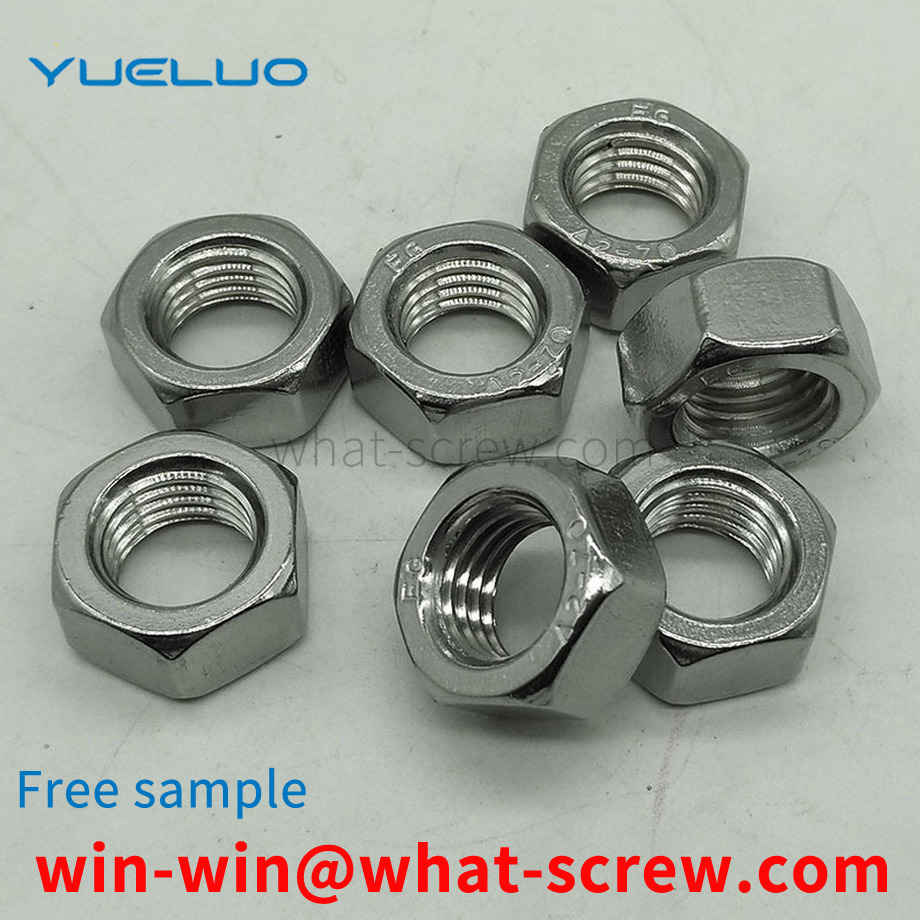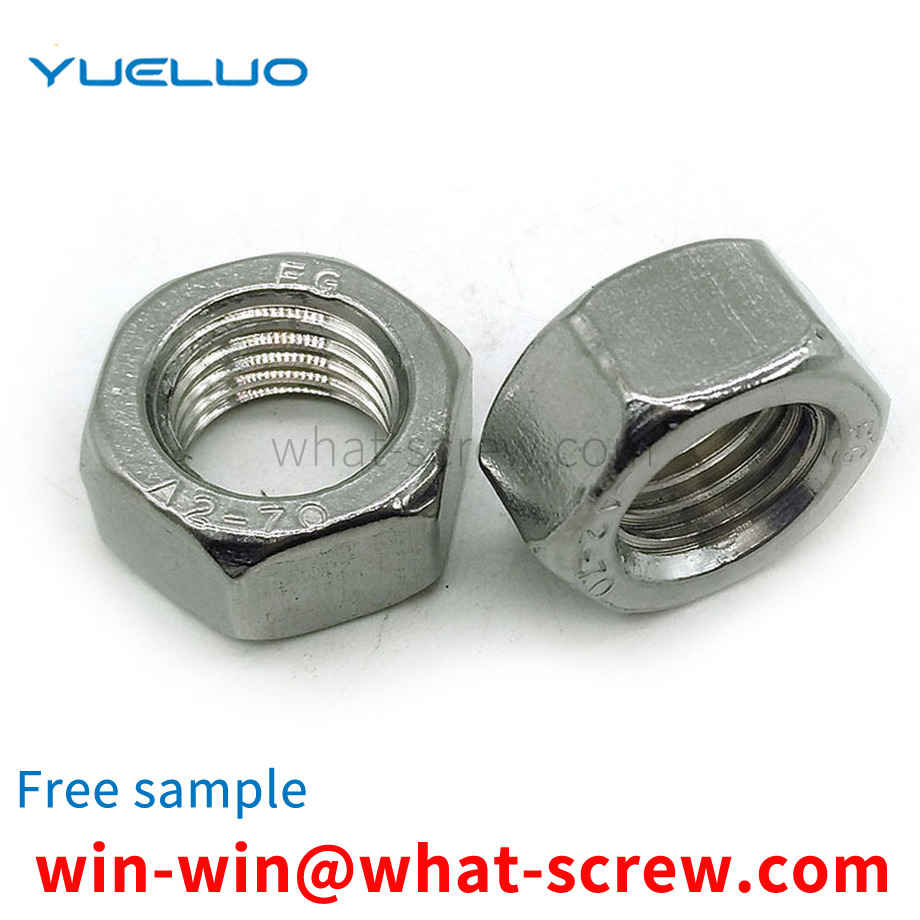The main categories of screws include ordinary screws, machine screws, self-tapping screws and expansion screws. Cap screws used to be limited to full-thread fasteners. Hex cap screw and Hex bolt Hex bolt As the name suggests, it is a male threaded fastener with a hexagonal head, designed to be turned with a wrench. According to the ASME B18.2.1 standard, the head height and shank length tolerance of the hexagon head screw (Hex cap screw) is smaller than that of the general hex bolt (Hex bolt), so the ASME B18.2.1 hexagon screw is suitable for installation in all hexagon bolts that can be used. places, also including places where the large hex bolts are too large to be used. Socket cap screw (also known as socket head screw or) is a screw with a hexagonal inner hole on the head, which can be tightened or loosened only after a hexagonal ruler (hex key, Allen wrench or Allen key) is inserted into the inner hole. The most commonly used hexagon socket head screws are cylindrical head screws with a head diameter of about 1.5 times the main diameter of the thread (1960 series). Countersunk head cap screw. The counterbore design allows the screw head to rotate without being exposed on the surface of the fixed object, so it is mostly used in places where the surface is small and traditional wrenches are inconvenient to use. Machine screw is generally a screw (4#~12#) with a diameter less than ¼ inches, usually full teeth and rotated by a screwdriver, such as slotted, cross or hexagon socket. Wood screws, machine screws; but can be divided into many categories according to different uses; machine screws can be divided into longitudinal tightening screws and horizontal expansion screws; according to the thread can also be divided into: A: Triangular thread (60 degrees ) : combined/locked/expanded B: triangular thread for pipe (55 degrees): combined/locked 3) C: trapezoidal thread (30 or 29 degrees): power transmission D: square thread (90 degrees): power transmission stainless steel screw Stainless Steel Anti-Drop ScrewsStainless Steel Anti-Drop Screws Machine (Treadmill) Screws And Shafts For Motorcycle Or Bicycle Needle Car Screws, Axes Screws And Shafts For Sewing Macing Socket Set Screws Stainless Steel Wide Thread ScrewsStainless Steel Coarse Thread Screws Stainless Steel High-Low Thread Screws Stainless Steel Machine Screws Stainless Steel Self Drilling Screws Stainless Steel Self Tapping Screws Stainless Steel Self Tapping Screws Stainless Steel Thread Cutting Screws Stainless Steel Triangle Stainless Steel Tri-Lobular Thread Screws Model Description P refers to the head type is PAN head; A refers to the pointed tail teeth, B refers to the flat tail teeth, namely PA round head pointed steel teeth, PB round head flat mouth steel teeth. Self-tapping type: ◆Round head self-tapping screw PA ◆Round head flat tail self-tapping screw PB ◆Round head cutting tail self-tapping screw PT ◆Round head belt self-tapping screw PWA ◆Round head belt and flat tail self-tapping PWB ◆Round head belt Jiecut tail self-tapping PWT ◆Countersunk head self-tapping screw KA ◆Countersunk head flat tail self-tapping screw KB ◆Countersunk head cut-tail self-tapping screw KT ◆Semi-countersunk head self-tapping screw OA ◆Big head self-tapping screw BA ◆Big head flat tail self-tapping screw BB ◆Large flat head self-tapping screw TA ◆Large flat head flat tail self-tapping screw TB ◆Large flat head cutting tail self-tapping screw TT ◆Thin head self-tapping screw CA ◆Thin head flat tail self-tapping screw CB ◆Cup head hexagon socket self-tapping HA ◆Drywall/Wallboard/Fiber Nails Machine Wires: ◆Round Head Machine Screw PM ◆Round Head Machine Screw PWM ◆Large Flat Head Machine Screw TM ◆Countersunk Head Machine Screw KM ◆Half Countersunk Head machine screw OM ◆Large head machine screw BM ◆Thin head machine screw CM ◆Cup head machine screw HM
Stainless steel screws are classified into austenitic stainless steel, ferritic stainless steel, martensitic stainless steel, and precipitation hardening stainless steel. The selection of stainless steel screws is also based on principles. Where to start, let you choose the stainless steel screws you need. After comprehensive and comprehensive consideration of these five aspects, the grades, varieties, specifications and material standards of stainless steel screws are finally determined. Austenitic stainless steel: the most basic alloying elements of austenitic stainless steel are chromium and nickel. The grade is a chromium-nickel austenitic stainless steel with a chromium content of about 18% and a nickel content of about 8%, often called 18-8 stainless steel. The element ratio of chromium and nickel basically ensures that the structure of the steel is stable austenitic ferritic stainless steel: 430 type ordinary chromium steel, its corrosion resistance and heat resistance are better than 410 type, magnetic, but it It cannot be strengthened by heat treatment, and is suitable for stainless steel screws with slightly higher corrosion resistance and heat resistance and general strength requirements. Martensitic stainless steel: Type 410 and 416 can be strengthened by heat treatment, with a hardness of 35 to 45HRC, and good machinability. They are used for general-purpose heat-resistant and corrosion-resistant stainless steel screws. Type 416 has a slightly higher sulfur content and is a free-cutting stainless steel. Type 420, sulfur content? R0.15%, improved mechanical properties, can be strengthened by heat treatment, maximum hardness value of 53 ~ 58HRC, used for stainless steel screws requiring higher strength. Precipitation hardening stainless steel: 17-4PH, PH15-7Mo, they can get higher strength than the usual 18-8 type stainless steel, so they are used for high-strength, corrosion-resistant stainless steel stainless steel screws. A-286, a non-standard stainless steel, has higher corrosion resistance than commonly used Type 18-8 stainless steels, as well as good mechanical properties at elevated temperatures. Used as high-strength, heat-resistant, corrosion-resistant stainless steel screws, can be used to 650 ~ 700 ℃. Austenitic stainless steel: The commonly used models are 302, 303, 304, and 305, which are the so-called 18-8 austenitic stainless steels. Both corrosion resistance and mechanical properties are similar. The starting point of selection is the production process method of stainless steel screws, and the method depends on the size and shape of stainless steel screws, and also depends on the quantity of production. Type 302 is used for machined screws and self-tapping bolts. Type 303 In order to improve machinability, Type 303 stainless steel is added with a small amount of sulfur and is used to machine nuts from bar stock. Type 304 is suitable for hot heading stainless steel screws, such as longer gauge bolts, large diameter bolts, which may be beyond the scope of the cold heading process. Type 305 is suitable for cold heading processing of stainless steel screws, such as cold formed nuts, hex bolts. Type 309 and Type 310, their Cr content and Ni content are higher than 18-8 type stainless steel, suitable for stainless steel screws working at high temperature. Types 316 and 317, both of which contain the alloying element Mo, have higher high temperature strength and corrosion resistance than 18-8 type stainless steel. Type 321 and Type 347, Type 321 contains a relatively stable alloying element Ti, Type 347 contains Nb, which improves the intergranular corrosion resistance of the material. It is suitable for stainless steel standard parts that are not annealed after welding or serve at 420~1013℃.
screw is a tool that uses the physical and mathematical principles of the circular rotation and friction of an object to fasten the mechanism of the object step by step. A screw is a common term for fasteners, an everyday colloquial language. Screws are indispensable industrial necessities in daily life: tiny screws used in cameras, glasses, clocks, electronics, etc.; general screws in televisions, electrical products, musical instruments, furniture, etc.; as for engineering, construction, and bridges, large screws are used. Screws and nuts; transportation equipment, airplanes, trams, automobiles, etc. are used together with large and small screws. Screws have important tasks in industry. As long as there is industry on earth, the function of screws will always be important. Screws have been common in people's production and life for thousands of years. According to the application field, it is the largest of human beings.
Bolt: A mechanical part, a cylindrical threaded fastener with a nut. A type of fastener consisting of a head and a screw (a cylinder with an external thread), which needs to be matched with a nut to fasten and connect two parts with through holes. This form of connection is called a bolted connection. If the nut is unscrewed from the bolt, the two parts can be separated, so the bolt connection is a detachable connection.
Dowels are made on the steering seat on the ball head of the car, and the rollers are assembled to the steering seat through the dowels. The prior art is manual driving of the pins, and the position of the pins is inaccurate when driving the pins, the labor intensity is high, the efficiency is low, and the quality of the steering seat is also affected. Therefore, it is necessary to design an automatic pin-driving mechanism to drive the pins into the steering seat. .
We have many years of experience in the production and sales of screws, nuts, flat washers, etc. The main products are: GB93 washer, Dacromet flat washers, lock nuts, high-speed steel cylindrical pins and other products, we can provide you with suitable fasteners solution.



















 Service Hotline
Service Hotline




